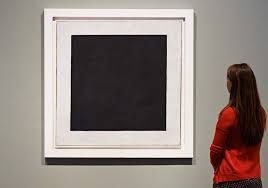A square in geometric terms is a regular quadrilateral. A square has four equal sides and four equal angles.
The square has many meanings. There is a Square point of sale system. A small device you add to an iPad to process credit cards.
In the art world, the discovery of the square ushered in modernism. You see abstract art becomes even more abstract when you can turn the piece in any direction and it still makes sense. Square format allows the piece to be hung with any of the four sides facing down.
In the early 1900s, a Russian painter named Kazimir Malevich painted a medium-sized square canvas with white around the edged and filled the middle with thick black paint and called it “The Black Square”.
Talk about making a statement. With this simple painting, Malevich declared the end of art. The end of life. Nothing left to paint. Lights out. Death. Finality. In that simple square painting, the futility of man was summed up and it all happened inside a square.
Malevich called his discovery “suprematist art” which became is an art movement, focused on basic geometric forms, such as circles, squares, lines, and rectangles, painted in a limited range of colors.
The problem with the “The Black Square” is that you can only do it once and you have to be the first one to do it. Anyone coming next has to add something interesting to the paintings. “The Black Square”. Sure those in the Suprematist movement did their best to expand the form with rectangles, a “White on White” square, and other colors, but really if you think about it, there is only so far you can go with “Colorforms” art.
Remember the original Colorforms art set? A set of colorful plastic geometric shapes kids could stick on a black background. Basically Suprematist Art in a box. Who knew you were an abstract artist when you were a child?
